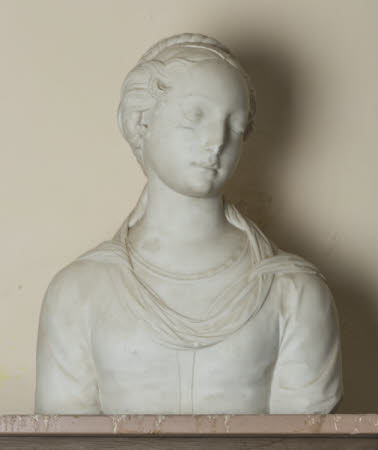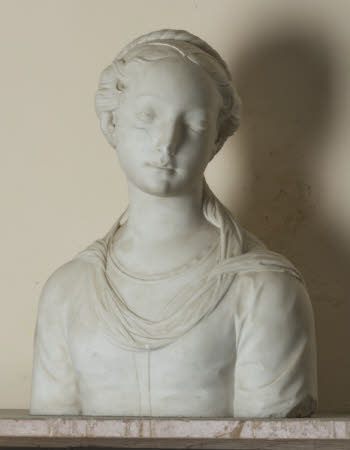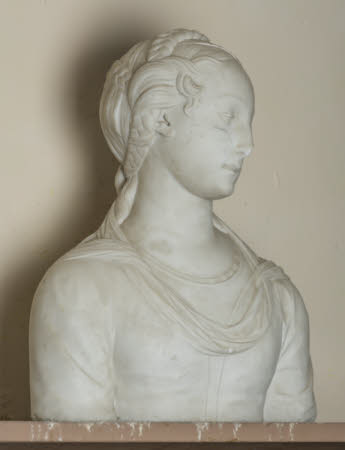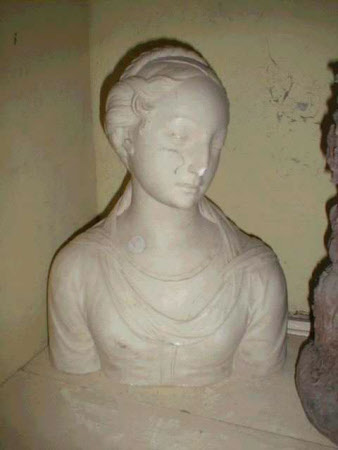Renaissance woman with braids
possibly Odoardo Fantacchiotti (1809 - 1877)
Category
Art / Sculpture
Date
circa 1850 - 1877
Materials
Marble
Measurements
444 x 355 x 160 mm
Place of origin
Florence
Order this imageCollection
Belton House, Lincolnshire
NT 436830
Summary
Marble, renaissance woman with braids, possibly Odoardo Fantacchiotti (1811-77), c.1850-77. A white marble bust of a woman in the neo-renaissance style, cut below the shoulders. The woman wears a dress with twisted loops of fabric draped around her neck and shoulders. Her hair is styled with elaborate braids, ribbons and a cap. She gazes to the left with heavy-lidded eyes.
Full description
The bust is a 19th century pastiche of 15th century Florentine portrait busts by artists like Donatello (1386-1466), Laurana (c.1430-1502), Verrocchio (1435-88) and Mino da Fiesole (1429-84). See, for example: Franceso Laurana: Beatrice of Aragon, 1471-4 (The Frick Collection, New York, 1961.2.86) Bust of a Lady, c.1470s (The Frick Collection, New York, 1961.2.01) Princess of the House of Aragon, c.1475 (National Gallery of Art, U.S.A., 1937.1.119) Andrea del Verrocchio: Bust of a Young Woman, 15th century (The Frick Collection, New York, 1961.2.87) A Lady, 1475/85 (National Gallery of Art, U.S.A, 1939.1.326). Mino da Fiesole: Portrait of a Young Woman, 1899, plaster cast after an original marble (Victoria and Albert Museum, London, REPRO.1889-93) Pastiches and actual forgeries of early renaissance sculpture emerged from the 1850s because of an international revival of renaissance art and architecture. The corresponding demand for original pieces of art from the period led sculptors like Odoardo Fantacchiotti and Giovanni Bastianini (1830-68) to produce high-quality imitations of Quattrocento sculpture which, in some cases, were sold and exhibited as genuine works (see, for example, Fantacchiotti’s forgery of a relief by Donatello, Victoria and Albert Museum, inv.no. 7582-1861 and Bastianini’s forgery of the bust of Lucrezia Donati, c.1865, Victoria and Albert Museum, London, 38-1869). Though this bust was produced for the renaissance revival market it is not necessarily a forgery. The bust is similar to others attributed to Fantacchiotti, including a bust of a renaissance lady (sold Sotheby’s, London, 19th & 20th Century European Sculpture, 16 November 2006, lot 126) and a bust of Eleonora d’Este (1515-75) by Fantacchioti dated 1848 (sold Sotheby’s, London, European Sculpture & Works of Art 900-1900, 9 April 2003, lot 91). Fantacchiotti, a talented sculptor trained at the Academy of Fine Arts, Florence, was commissioned by the Brownlows to produce NT 436810, a bust of a woman thought to be Lady Adelaide Talbot (1844/5-1917) the wife of Adelbert, 3rd Earl Brownlow (1844-1921). The bust is inscribed ‘Odoardo Fantacchiotti Scolpiva in Firenze Anno 1861’. Alice Rylance-Watson October 2018
Provenance
Purchased with a grant from the National Heritage Memorial Fund (NHMF) from Edward John Peregrine Cust, 7th Baron Brownlow, C. St J. (b.1936) in 1984.
Credit line
Belton House, The Brownlow Collection (acquired with the help of the National Heritage Memorial Fund by the National Trust in 1994)
Makers and roles
possibly Odoardo Fantacchiotti (1809 - 1877) , sculptor
References
Penny 1992: Nicholas Penny, Catalogue of European Sculpture in the Ashmolean Museum, 1540 to the Present Day, vol. I, Italian, Oxford, 1992, pp. 30-31 Warren 2005, Jeremy Warren, 'Forgery in Risorgimento Florence: Bastianini's "Giovanni delle Bande Nere" in the Wallace Collection', The Burlington Magazine (CXLVII), November 2005, pp. 729-741, pp. 729-741 Moskowitz 2006: Anita F. Moskowitz, 'The Case of Giovanni Bastianni-II: A Hung Jury?' Artibus Et Historiae, vol. 27, no. 54, 2006, pp. 201–217, pp. 201–217



